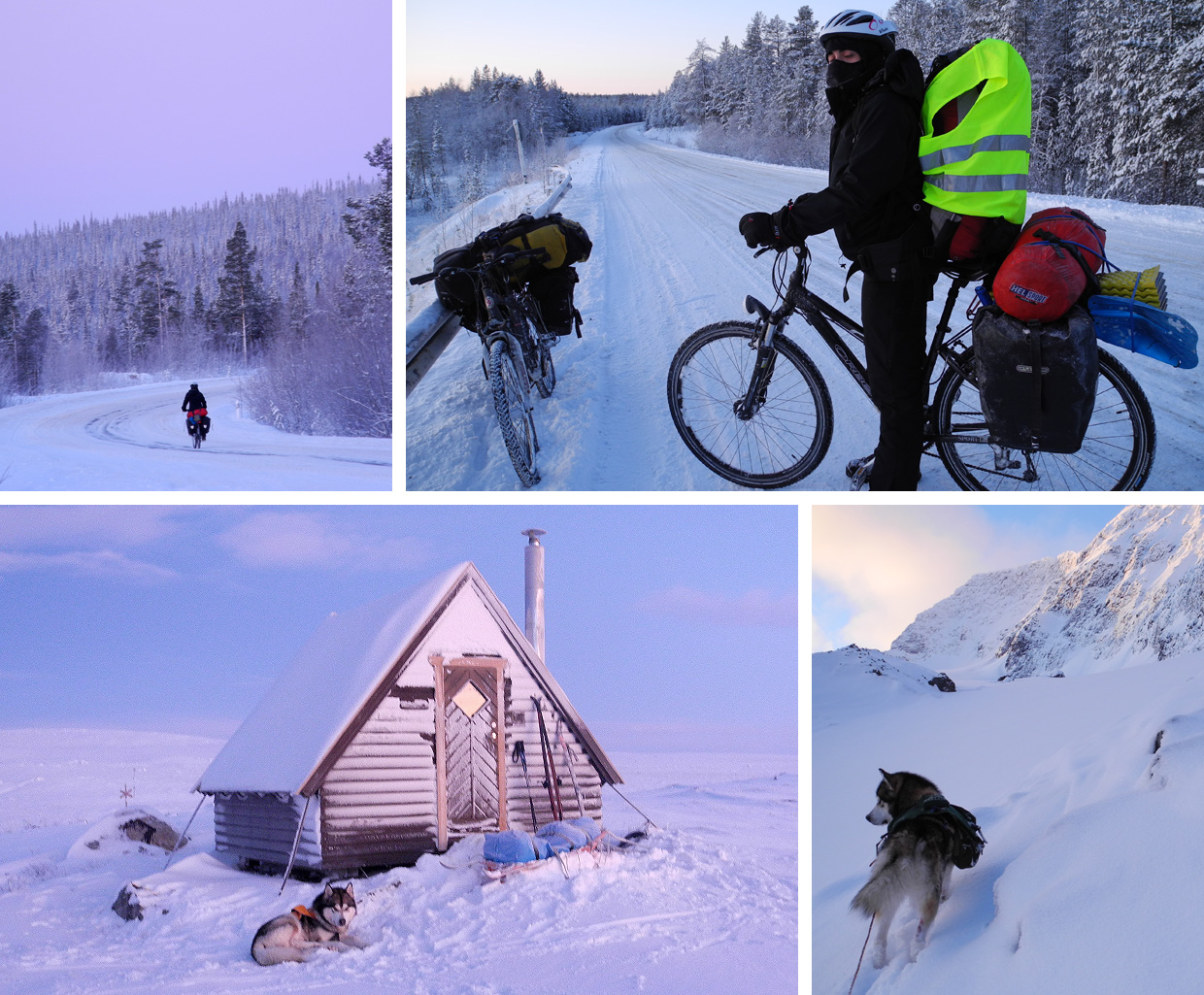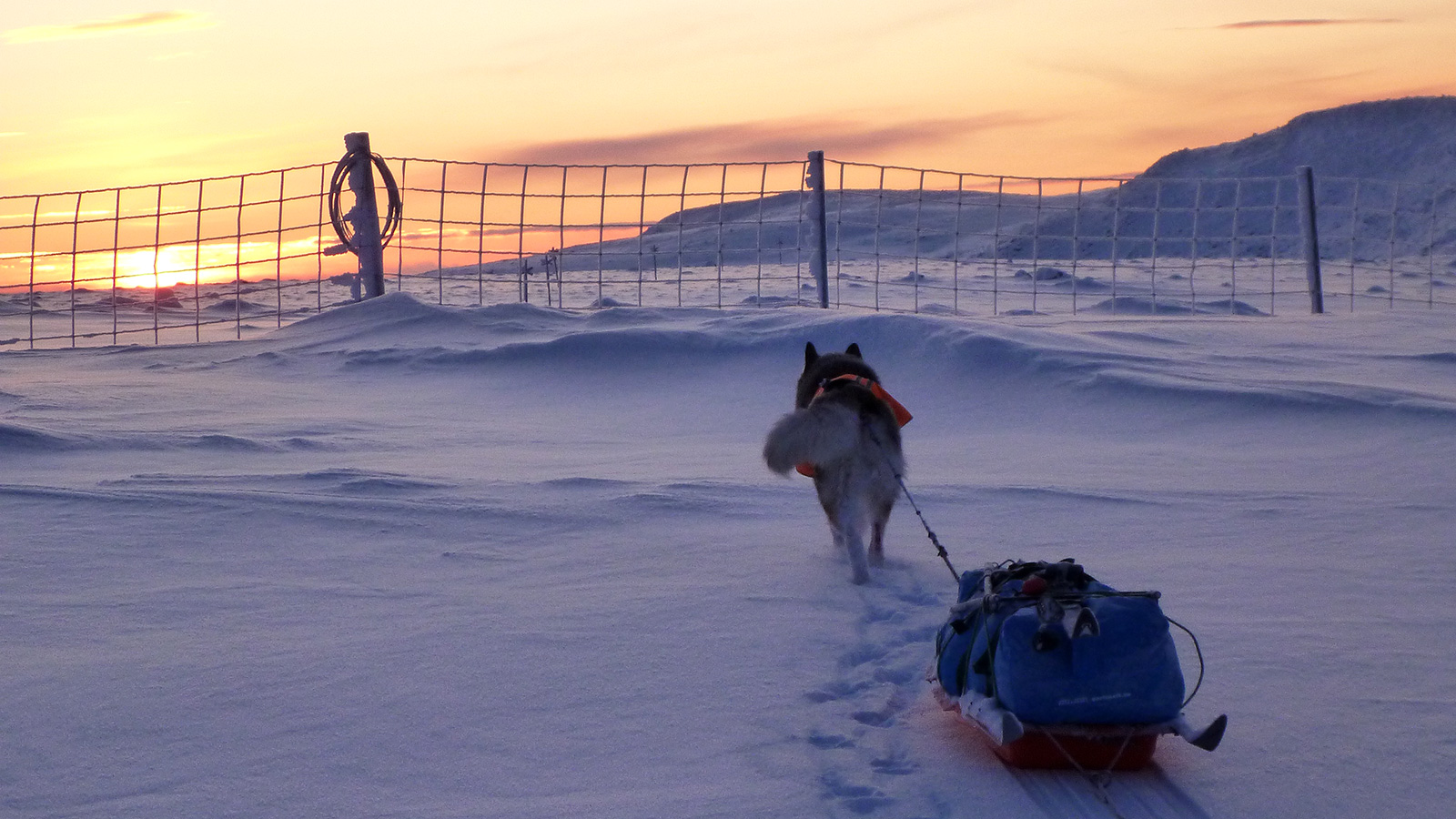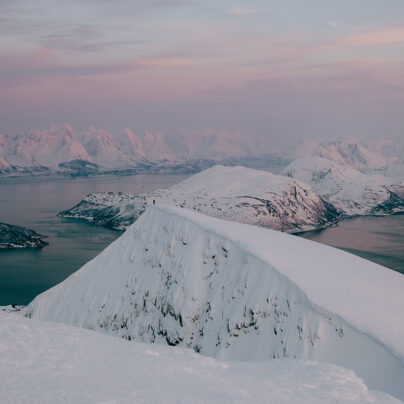Across the Arctic Blue Night
José Mijares
An extraordinary mild winter forced Jose to leave the skis behind in some sections, which he instead completed on snowshoes and – on the Russian stage – cycling. Jose shared the initial and final sections of the 6-stage trip with friends but, most of the time, Jose relied on his loyal canine mate “Lonchas”, an Alaska Malamute which shares most of Jose’s expedition.
Seen from Jose’s “southern eyes” perspective, the itinerary, mostly decided while on the go, was a unique way to penetrate into the genuine north, a sort of pilgrimage to the silent heart of the Arctic.
I’ve always got a Lapland map at hand, wherever I am. I like to spend time looking at the colorful lines drawn on it by my own hand – one for each route completed – and dream of new ones covering new areas. My latest trip was however, in my opinion, the most aesthetic and logical of all: 1.200km across Lapland, without motorized support, during the Arctic wintry night.
I had been dreaming of this route in the same way others dream of a long pleasure cruise, a race car or a lion’s head.
Otherwise, I reckon I like travelling solo, but I am not a loner. Thus, I happily agreed when two friends asked me to share patchs on the first and last stages of the trip: Ainoa Aldalur and Javier Pedrosa respectively. The rest of the time, I relied on “Lonchas”, my regular mate. He is pure breed Alaska Malamute originally named “Longyearbyen” (after Svalbard’s capital) but widely known by the shorter nick-name. Thanks to social networks, “Lonchas” is getting an increasing number of fans around the world and definitely becoming more famous than me.
Kick Off On Wheels
The trip’s first stage started at Murmansk, in Russian Lapland, at the end of November – right at the beginning of the polar night. Due to the extraordinary mild 2011-12 winter conditions, Ainhoa and I switched from cross-country skis to bicycles, and rode along 300 km on iced-up roads to Ivalo, on the other side of the Finnish border.
The experience was mostly remarkable due to the travelling in the dark, camping for the night in thick forests by the road and the chance to meet some particular characters on the way: truck drivers, custom-agents on deserted frontier posts, petrol station attendants on high heels and tights, and lumberjacks drowning their salary in vodka and karaoke jams. Ainhoa, young and eager to live the adventurous life, shared her enthusiasm at every event, every new person we met, and every turn of the road.
The experience was mostly remarkable due to the travelling in the dark, camping for the night in thick forests by the road, and the chance to meet some particular characters on the way: truck. Drivers, custom-agents on deserted frontier posts, petrol station attendants on high heels and tights, and lumberjacks drowning their salary in vodka and karaoke jams.

There were no cabins to spend the night in, we were in the middle of December and the darkness was overwhelming: barely two hours of twilight sun faded into a pitch-black night. We marched with the head torches on, desperately searching for cairns marking tracks, which were often hard to find in the dark.
For the second stage, from Ivalo to Inari, I picked Lonchas from a friend’s house in Norway, drove back to the point I had finished the cycling part, and set off what was supposed to be a rather easy, enjoyable walk on frozen Inari lake. Just that, for the first time in the locals’ memory, the lake surface was not yet solid. Instead, we had to struggle along for 100km on rough tundra terrain, with virtually no snow to drag the sledge on.
There were no cabins to spend the night in, we were in the middle of December and the darkness was overwhelming: barely two hours of twilight sun faded into a pitch-black night. We marched with the head torches on, desperately searching for cairns marking tracks, which were often hard to find in the dark.
Eventually they reached a colder area where lakes were solid on top – but not too much. Lonchas’ polar-dog instinct was essential in such circumstances: he jumps back the second he smells water and retreats to safer terrain – and so did I. Also, as he’s 50kg heavy, I was confident that ice would hold my weight as long as Lonchas, walking ahead of me, passed with no further problem.
Lonchas’ Accident
Colder conditions would settle in during the following stage which started at Karasjok, on the Norwegian border. Progress with back-country skis had a setback though: on a too fast descent, I accidentally ran over Lonchas, who was cut on two of his legs with my ski edges. Worried, I renounced to the “self-supported” tag for the trip and asked for help, in order to get Lonchas in a car to a nearby town for vet-treatment and some days of mandatory rest and recovery.
The fourth stage, from Kautokeino to Kilpisjarvi, crossed the routes of the Samis, the reindeer-herders who, as they passed by on their snow-cats, used to stop for a cup of coffee a short chat and valuable advice on directions and route conditions ahead.
Here, in pure Arctic environment and well off the beaten track, Lonchas and I spent Christmas’ Eve in a cabin with -17ºC temperatures. Four days later we climbed Mt. Halti – Finland’s roof. Funny enough there were people in nearly every cabin we spent the night in – it seemed that no one wanted to spend Christmas at home! It was fine with us though, since we’d made some cool friends on the way: a Czech truck-driver on a lonely holiday and an Estonian couple who travelled dress as ancient Vikings. On New Year’s eve, we shared a bungalow in Kilpisjarvi, right on the border-point between Finland, Norway and Sweden, and celebrated welcomed 2012 together… twice: there were fireworks on the Finish side of the place, and one hour later midnight struck on the Swedish time-frame, right on the other side of the bay.

Adventure Land
The following stage was a genuine adventure since, rather out of the blue, I discarded all previous plans and went instead for a new route across an area I had never been before. The result was an amazing experience of bitter cold, absolute loneliness, stunning landscapes in Arctic blue light and overwhelming beauty.
In spite of getting involved in a fight with a Sami dog which ended up with ME badly bitten (that’s what happens when you try to get in the middle and ask for peace), I can ensure that Lonchas is the best expedition mate I could think of. I’ve had several companions on different trips across Lapland, but there is something special about travelling with Lonchas. I can’t explain but, somehow, marching with just my dog makes the experience more intense and genuine.
It was also on that stage that we saw the sun rising on the horizon, after 46 days of absence. It was a moving moment: something we usually take as routine, turned into a surprise, a remarkable phenomenon and a breath-taking show of bright colors burning on the ski. From that day on, the promise of a rising sun would provide all motivation needed for a swift progress.
At the end of the stage in Kiruna though, I got news of familiar issues which required me to cut the final stage and return home earlier than expected. I still had, however, a week left to reach Ritsem and return on a touring trip around Kebnekaise, the highest peak in Lapland. The climb to the top added an alpine side to the trip and, by the way, proved that Lonchas was as a natural-born climber. I’ve lived in northern Norway for 10 years already, I have seen plenty of Arctic landscapes and northern lights – but Kebnekaise’s summit views and the descent under spectacular northern lights will remain in memory forever, as some of the most magic moments of my life.
I’ve often thought about the aesthetic reasons that pushed me towards this trip. A line on a map, a track on a frozen lake, a lonely row of some wild animal’s foot-prints, our own tracks left by the skies, the sledges and Lonchas’ paws… I can see art in these lines that I later draw on my maps – they provide landscape with a particular, personal look. This is how I feel about it, once I am back at home in Cape North and the experience has settled in. This is the story behind a new line on my old, ragged, Lapland’s sentimental map.
I’ve often thought about the aesthetic reasons that pushed me towards this trip. A line on a map, a track on a frozen lake, a lonely row of some wild animal’s foot-prints, our own tracks left by the skies, the sledges and Lonchas’ paws… I can see art in these lines that I later draw on my maps – they provide landscape with a particular, personal look.

Born in sunny Spain, José Mijares (44) was attracted to Polar areas from a young age. He has worked as a tourist guide specialising in Arctic regions and has climbed over 100 summits in the Andes, Africa, South East Asia, New Zealand and Mexico. As an individual explorer, he has completed crossings across Greenland, the Baltic Sea, Patagonia’s North Icecap or Svalbard.
Mijares moved to Norway 10 years ago, where he currently lives and runs “Artico” together with his wife, Gloria.
Find out more via Jose’s website or on Facebook or Vimeo. Jose is proudly supported by Devold.





